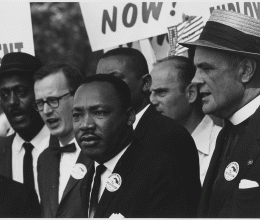Racism has been in the national news in recent weeks thanks to the inflammatory words of Donald Sterling, owner of the Los Angeles Clippers, and Cliven Bundy, wealthy renegade rancher in Nevada. Both have been widely condemned and Sterling faces serious consequences from the NBA, but in the wake of their pronouncements there can be no doubt that even the most crude forms of racism are alive and well in the United States.
Just don’t try telling that to the Supreme Court. In a series of decisions in the past year, a majority of the U.S. Supreme Court has overturned large portions of the Voting Rights Act and undermined affirmative action in higher education. The subtext appears to be that they believe the problem of racism has largely disappeared and we no longer need active legal protections for racial justice.
If only that were true. The real problem of racism goes much deeper than the loud-mouthed bigotry of a few prominent individuals. No one has a right to violate anti-discrimination laws, but even those with obnoxious views have the right to express their opinions without government censorship, while others are free to respond to their views, and there is often enough blowback to discourage open, public bigotry. But open bigotry is just the tip of an iceberg of hidden racism, unconscious bias, structural racism and unequal protection.
All you have to do to see the depth of racial injustice in our society is to look at wealth and income statistics, joblessness, health patterns, incarceration rates and numbers on death row. So many African American men have been incarcerated, often losing voting rights in the process, that Michelle Alexander has described our criminal justice system as a “New Jim Crow.” Racial profiling is rampant in police work, including stop and frisk policies and traffic arrests. An ACLU study last year found that arrest and incarceration for marijuana possession nationally is about four times as likely for African Americans than for white Americans, even though usage rates are about the same.
Sometimes racism is blatant, but bias doesn’t have to be conscious or intentional for its effects to be real. This is true for the police, and it is true for all of us at some level. If you don’t understand how racial profiling can happen without conscious bigotry, watch the video above and think about its meaning.
Racism is not just a problem in some other part of the country, either. Racism is alive and well right here in Colorado. At the ACLU of Colorado, we see the effects of racism every day. With few exceptions, most of the statistics of racial inequity nationally are mirrored in similar patterns here. Even blatant racism is not uncommon. Just consider these recent examples:
A racist letter targeting a homeowner near Five Points. A hostile sign posted at a Greeley truck stop. Complaints of racial bias at the CU Dental School. A hostile environment for Latinos at an Adams County school.
A majority of the justices on the Supreme Court are badly out of touch with the realities of racism in the United States. Racism won’t go away by pretending we live in a post-racial society. We have a long way to go and difficult work to do to ensure equal protection in voting rights, in criminal justice, in economic and educational opportunity, and in access to civil liberties.
Racism is Alive and Well
Related Issues
Related content
People v. Johnson and People v. Austin
November 8, 2023People v. Johnson and People v. Austin (Amicus)
November 6, 2023
Letter to El Paso County Redistricting Commission regarding...
July 31, 2023
Blog: Juneteenth is our clarion call
June 12, 2023HB23-1307 Juvenile Detention Services And Funding
June 7, 2023Clark v. Colorado
April 25, 2023